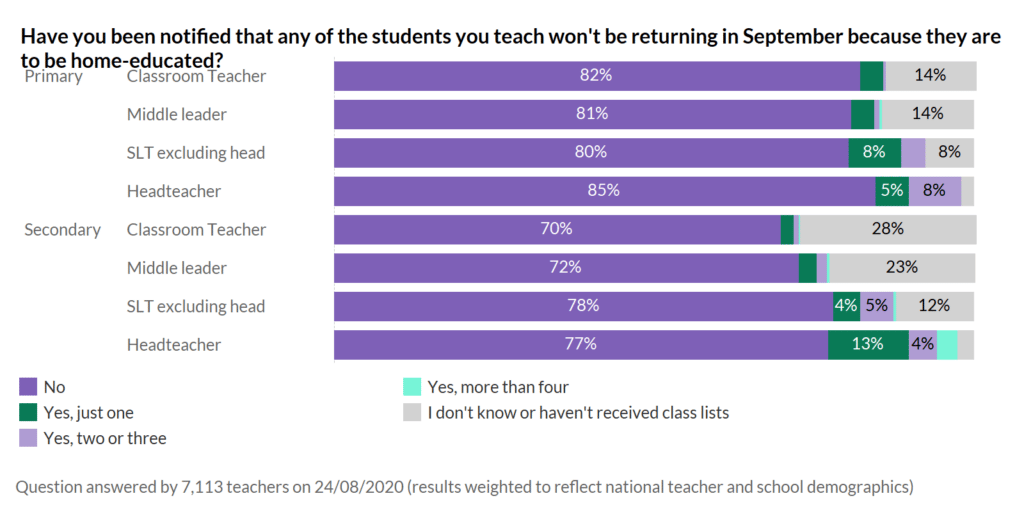September 1st. The first day of autumn in 2020 and the beginning of new possibilities. Except for the few of you who have been in school since August (hello Scotland and Leicester!), most of you will be starting school again this year. For many it will be the first time back in full classrooms since March and things will look different. You’ve already told us that many of you are without a classroom for the first time, or will be experiencing staggered starts, or socially-distanced lunch breaks!
When we started Teacher Tapp, this week, three years ago in 2017, we did so to look at what was normal. With your help, over the next months, we aim to look at what is normal for now, and to advocate for what this means for teachers and pupils, and how government needs to respond.
In the meantime, here are our final findings from the summer….
1. It’s school, but not as we know it
Last week our blog focused on changes to practical arrangements across the school. This week we looked at what and who you think you’ll be teaching this academic year.
First up, will you curriculum look different? For some, yes. 44% of primary and 28% of secondary state school teachers have been asked to adapt their normal curriculum to take account of missed learning between March and July. (Amazingly, over 3-in-20 of you say you don’t know what you’ll be teaching yet!) Doing so will mean a lot of adaptations to lesson planning, which means the workload gains of the past few years are likely to diminish over this term.

Some students will stay at home with their families in September, most likely for health reasons. However, most of you expect this to be less than one student per class. Those of you teaching in lower income communities expect this figure to be a little higher. Perhaps because many of these communities have seen much higher infection rates as a result of their urban location and typical household composition. In a few weeks, we’ll find out who has actually returned to school.

Commentators have speculated that some parents enjoyed home schooling so much that they may decide to do it on a permanent basis. We asked whether you know of any former students who will now be home schooled. The answer is generally ‘no’.
Headteachers, who would have the best idea of changes in roll, sometimes know of one or two students, but the data suggest the vast majority of parents have no desire to home-school on a permanent basis!

2. A pandemic doesn’t change everything
After 3 years of checking… it seems the bullet marker is the solid winner as best marker pen of all time. With three years of results, and no ground made by #teamchisel, despite their social media efforts, it is time to call this one. Bullets are the most loved, by far.

Chisel fans knew they were likely to lose the board pen wars again, so started proclaiming on social media that their preference was a sign of their superior handwriting. Were they correct?
In advance of the marker question, we asked you to rate your own board hand-writing skills. Do chisel tippers have better hand-writing. Um… no!

What we did find, however, is a preference for chisel tips among English teachers and, curiously, those of you in KS2. Is this because you are modelling joined up handwriting the most? Meanwhile, MFL teachers came out as the strongest bullet types.

All of which got us thinking. Given English teachers seem to love handwriting so much, does it mean they are the best handwriters? Apparently not! The (self-reported) best of the bunch are the EYFS/KS1 teachers, who have to be very clear in their writing otherwise the students are unlikely to be able to read anything, closely followed by the language teachers.

Ultimately, what this does teach us, is that if you are in charge of buying marker pens for your school, it’s probably safest to err on the side of caution and buy mostly bullets!
3. A final question!
Every year the beginning of term involves teachers scratching their heads to remember passwords forgotten over the summer. But, this year, there are teachers who won’t have been back to the school building for an even longer stretch of time. Will this mean a headache for IT staff!
The figures below compare how many passwords people felt confident they would remember when returning to school last year vs this year. As you can see – many fewer teachers think they will remember all of their passwords (24% compared to 37% last year). Instead, more people now think they will remember nearly all of them. That’s a good amount of confidence, but let’s see how it goes when you’re stood in front of the photocopier desperately trying to remember your codes!

4. Have you moved schools? Or changed jobs?
One last note… Teacher Tapp analysis relies on us having up-to-date information about the schools and jobs that our users are in, so that we can do all the cool analysis above. Some things that we ask you never change (for instance, what sort of school did you attend as a kid), but other things do need an annual update. We will therefore be asking in the next week about changes to your jobs or school.
If you have changed school, please update the new school name and postcode in the top left menu of the app. This will enable us to recalculate all the critical data and ensure Teacher Tapp stays accurate.





